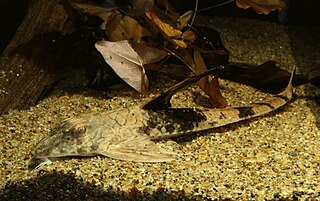
Catfish are a diverse group of ray-finned fish. Named for their prominent barbels, which resemble a cat's whiskers, catfish range in size and behavior from the three largest species alive, the Mekong giant catfish from Southeast Asia, the wels catfish of Eurasia, and the piraíba of South America, to detritivores, and even to a tiny parasitic species commonly called the candiru, Vandellia cirrhosa. Neither the armour-plated types nor the naked types have scales. Despite their name, not all catfish have prominent barbels or "whiskers". Members of the Siluriformes order are defined by features of the skull and swimbladder. Catfish are of considerable commercial importance; many of the larger species are farmed or fished for food. Many of the smaller species, particularly the genus Corydoras, are important in the aquarium hobby. Many catfish are nocturnal, but others are crepuscular or diurnal.

Loricariidae is the largest family of catfish, with 92 genera and just over 680 species. Loricariids originate from freshwater habitats of Costa Rica, Panama, and tropical and subtropical South America. These fish are noted for the bony plates covering their bodies and their suckermouths. Several genera are sold as "plecos", notably the suckermouth catfish, Hypostomus plecostomus, and are popular as aquarium fish.

Corydoras is a genus of freshwater catfish in the family Callichthyidae and subfamily Corydoradinae. The species usually have more restricted areas of endemism than other callichthyids, but the area of distribution of the entire genus almost equals the area of distribution of the family, except for Panama where Corydoras is not present. Corydoras species are distributed in South America where they can be found from the east of the Andes to the Atlantic coast, from Trinidad to the Río de la Plata drainage in northern Argentina. Species assigned to Corydoras display a broad diversity of body shapes and coloration. Corydoras are small fish, ranging from 2.5 to 12 cm in SL., and are protected from predators by their body armor and by their sharp, typically venomous spines.

Clarias is a genus of catfishes of the family Clariidae, the airbreathing catfishes. The name is derived from the Greek chlaros, which means lively, in reference to the ability of the fish to live for a long time out of water.

The Ariidae or ariid catfish are a family of catfish that mainly live in marine waters with many freshwater and brackish water species. They are found worldwide in tropical to warm temperate zones. The family includes about 143 species.

Pterygoplichthys, sometimes collectively known as janitor fish, is a genus of South American armored catfishes. These fish are commonly known as sailfin armoured catfish or sailfin plecs, especially in the aquarium trade.

Trichomycterus is a genus of fish in the family Trichomycteridae, the largest genus of its family with over 170 species currently described. This genus is native to freshwater habitats in Central and South America. These fish are generally small, usually about 5 to 15 cm (2–6 in) in standard length, although the largest, T. rivulatus, can reach more than twice this size. Species differ from one another primarily in body proportions, fin ray counts and colouration. Despite their relatively small size, some, such as T. punctulatus, support fisheries and are important in the local cuisine.

Synodontis is the largest genus of mochokid catfishes. It is the biggest genus within the 10 genera and 190 different species in the family Mochokidae. Synodontis has over 131 different species within the genus. Synodontis are also known as squeakers, due to their ability to make stridulatory sounds through their pectoral fin spines when handled or disturbed. Synodontis make a sound that sounds like squeaking by rubbing their spines together. They do this when they have been frightened or when they become angry. Synodontis may also squeak when they are taken out of the water. These catfish are small- to medium-sized fish with many species exhibiting attractive spotted markings. Some species are also known for naturally swimming belly-up, earning the name upside-down catfish. Some of these species are Synodontis contractus and Synodontis nigriventris. While some of these species are known to swim upside down, another species, Synodontis multipunctatus, is a brood parasitic cuckoo catfish,there are two other species Synodontis petricola and Synodontis grandiops are also called brood parasitic cuckoo catfish.

Bagrichthys is a genus of bagrid catfishes.

Agamyxis is a genus of thorny catfishes.
Pseudomystus is a genus of catfishes of the family Bagridae.

Ameiurus is a genus of catfishes in the family Ictaluridae. It contains the three common types of bullhead catfish found in waters of the United States, the black bullhead, the brown bullhead, and the yellow bullhead, as well as other species, such as the white catfish, which are not typically called "bullheads".

Leporacanthicus is a genus of suckermouth armored catfishes native to South America.

Pangasius is a genus of medium-large to very large shark catfishes native to fresh water in South and Southeast Asia. The term "pangasius" is sometimes used to specifically refer to the commercially important basa fish, P. bocourti.

Ictalurus is a genus of North American freshwater catfishes. It includes the well-known channel catfish and blue catfish.

Arius is a genus of catfishes of the family Ariidae. The genus Arius is distributed in brackish and fresh waters of Eastern Africa and south to Southeast Asia.

Cavefish or cave fish is a generic term for fresh and brackish water fish adapted to life in caves and other underground habitats. Related terms are subterranean fish, troglomorphic fish, troglobitic fish, stygobitic fish, phreatic fish, and hypogean fish.

The granulated catfish is a species of thorny catfish found in the Paraná and Amazon basin as well as the coastal drainages of Suriname and Guyana. This species is commercially caught for human consumption as well as being displayed in public aquaria.
Pterodoras rivasi is a species of thorny catfish found in the Orinoco River basin of Colombia and Venezuela. This species grows to a length of 55 centimetres (22 in) SL.

















